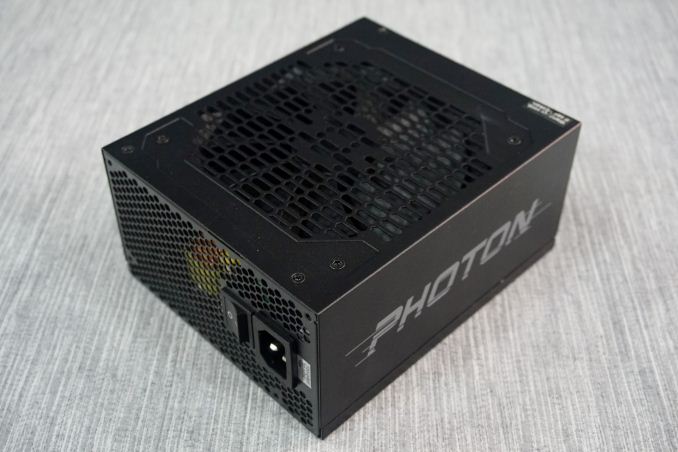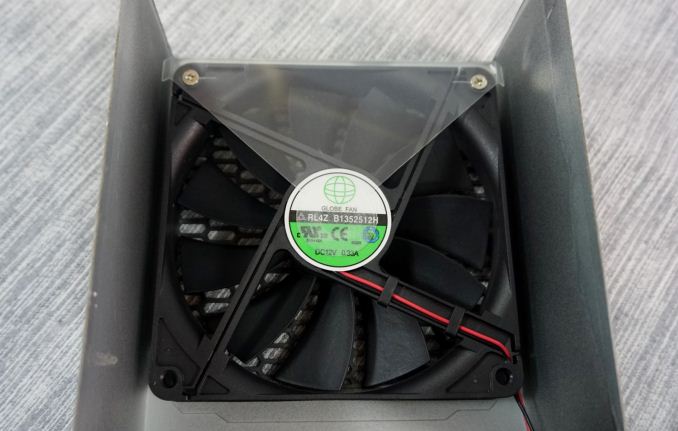The Rosewill Photon 1050W Review
by E. Fylladitakis on March 24, 2015 8:00 AM EST- Posted in
- Cases/Cooling/PSUs
- Rosewill
- 1050W
- Sirfa
External Appearance
The only thing that truly differentiates the Rosewill Photon from any other black PSU is the fan finger guard, which is not a separate part but an elongated honeycomb pattern punched on the steel chassis itself. Other than that, the series logo is printed on the right side of the chassis making it visible from a windowed side panel only if the PSU is installed with its fan facing upwards. There is absolutely nothing on the left side of the unit; the spectator will see only a plain, matte black surface from the side of a case if the unit is installed with its fan facing downwards. The sticker with the specifications of the PSU is found at the top side of the chassis.
Only the numerous connectors for the modular cables can be seen at the front of the chassis, with a basic printed legend indicating which connector corresponds to each cable. The CPU and PCI Express cables share the same connectors, while the split 10-14 pin connector is for the 24-pin ATX cable and the smaller connectors are for SATA/Molex cables.
Internal Design
A black 135mm fan from Globe is responsible for the cooling of the Photon 1050W. The B1352512H is a ball bearing fan with a maximum speed of 1500RPM, meaning that it can get significantly loud if the unit is heavily stressed. Of course, a thermal control circuitry adjusts the speed of the fan according to the load and the temperature of the unit, so we will examine how it truly behaves during our testing.
A look inside the Rosewill Photon 1050W instantly reveals that the OEM behind this unit is Sirfa, This is the same company who owns High Power as their own retail brand. Sirfa is not a bad OEM at all but it is not yet highly reputable among enthusiasts, mostly due to a few not-so-good low-cost designs they supplied through Sirtec in the past. The filtering stage is textbook, with four Y capacitors, two X capacitors and two filtering inductors. We also found a transient suppression diode and a classic fuse. There are two main rectifying bridges, sandwiched on a small, dedicated heatsink. Two large Nippon Chemi-Con 400V/390μF capacitors can be seen in the PFC stage, alongside an equally large filtering inductor. Two low resistance power transistors by Infineon form a half-bridge primary inversion stage, while eight transistors by the same company create the secondary conversion stage and generate the 12V output.
Quality wise, the Photon 1050W ranks above average, but it is not perfect. The quality of the components is outstanding; all of the main components come from reputable manufacturers - the electrolytic capacitors are all from Nippon Chemi-Con and the polymer capacitors are supplied by Fujitsu Electronics. Sirfa could improve their design and assembly quality a little though - the design is a little messy and there are several joints amateurishly soldered. These will not be a problem but they are also not something enthusiasts like to see in products that are supposed to compete in the high-end segment of the market.

























42 Comments
View All Comments
romrunning - Tuesday, March 24, 2015 - link
Hey, I knew someone would give me the actual % difference. :)Not to be overly pedantic, I was just thinking a different word would be better - like "significant". What if you had another test that showed a 10% variance? What word would be appropriate then - "ginormous"? Words that describe the scale of difference begin to lose impact when they start out with a descriptive word that is a little too large in scale itself.
romrunning - Tuesday, March 24, 2015 - link
Anyway, just having a little fun here. E.Fyll, you did a nice job with the review!I also agree with the opinions given here that we need more 500-600W reviews. That is what I think most buy when they are building their own PCs with a single GPU, and that's where we need the expert guidance/reviews to make the most informed purchase.
E.Fyll - Wednesday, March 25, 2015 - link
Each word is appropriate for a specific purpose. In this case, an energy conversion efficiency drop from 2% to 3.7% just from the increase of the ambient temperature is massive. If there was a 10% drop in that test, something would be horribly wrong.As you mentioned, the scale itself is important. However, the scale is not 0-100%. Even the entirety of the ECE scale itself is 60-100% (you cannot really have 0.1% efficiency with such a PSU). In this specific test, the maximum of the scale that is being described is perhaps a 0% to 5.5-6% drop (you cannot have a 90% drop either), meaning that going from 2% to 3.7% is a move a whole 1/3 down the scale. The large drop at maximum power output is also a sign of overloading - units rated at 50°C do not (should not) behave like that, the efficiency decline due to the higher temperature is even across the entire load range.
You just gave me an idea for a new graph. Thank you.
You see, everything is relative. An efficiency loss of 1.7% does not initially sound much, I agree. However, when you consider that the losses nearly double and that a good PSU should not even reach 1% during that test, let alone 3.7%, the huge difference becomes obvious.
Dr.Neale - Thursday, March 26, 2015 - link
Actually, a 3.7% decrease in efficiency REALLY IS MASSIVE.For example, a 3.7% DECREASE IN EFFICIENCY from 90.0% to 86.3% means that the waste heat produced by the PSU increases from 10.0% to 13.7%, or a 37% INCREASE IN HEAT OUTPUT.
I would call 37% a MASSIVE INCREASE in anything!
The amplification factor, call it A, is obviously given by:
A = 100% / (100% - Efficiency)
In my example, A = 10. In an 80+ Platinum rated PSU operating at 93.3% Efficiency, A = 15. Even in a plain vanilla 80+ PSU operating at only 80% Efficiency, A = 5.
So the % increase in HEAT is roughly 10X the % decreased in EFFICIENCY. It would behoove you to be mindful of this.
So
Dr.Neale - Thursday, March 26, 2015 - link
Sorry for the typos at the end.But the drive for HIGH EFFICIENCY is mainly motivated by the desire for LOWER HEAT PRODUCTION, hence LOWER COOLING REQUIREMENTS, hence LOWER NOISE.
The savings on your electricity costs are merely a fringe benefit.
One other thing... Seeing as how a name-brand high-efficiency PSU with a 7-YEAR WARRANTY will likely last 10-20 years before failure, and moreover that the QUALITY OF THE POWER DELIVERY (voltage accuracy and ripple) strongly influence the MTBF of the other components in your computer build, WHY CHEAP OUT ON YOUR PSU ???
My father once bragged to me about how much money he saved by only buying a cheap $20 watch EVERY YEAR. I responded by showing him my $200 Citizen solar-powered watch, with the titanium bracelet and sapphire crystal, which was 10X as accurate, looked way nicer, and over 10 years would cost the same, and over 20 years half as much as he would spend on cheap, cheap-looking, and minimally accurate watches.
Better to buy a GOOD one once, than to buy a CHEAP one over and over again.
That's my philosophy for any (so-called) durable goods.
The_Assimilator - Tuesday, March 24, 2015 - link
Considering its price and features, I feel that this PSU deserved at least a Bronze award.E. Fylladitakis, please can you add a cable/connector table to your future reviews, similar to e.g. JonnyGURU? It's a bit of a pain to have to find the manufacturer's page, and available connectors play a big part in the selection criteria for a PSU. For example this model has 8x 6+2-pin PCIe and 15 SATA connectors, which is quite generous for a 1050W unit.
E.Fyll - Wednesday, March 25, 2015 - link
I simply do not do awards. Not at all, ever. Every specific product has its own advantages, disadvantages and market potential. For user X, a "bronze" product might be much better than a "gold" product, even if they are similar, just because the former suits the needs of the user better. Everything is relative.I'll consider the tables. It is not difficult, I just thought that it is something too redundant.
seerak - Tuesday, March 24, 2015 - link
While we're suggesting things to review (like midrange and lower end units), there's something I'm not seeing in reviews that really should be in there: UPS compatibility testing.Active power factor correction (PFC) doesn't seem to be a feature on this unit, but it's becoming increasingly common, and many of those units don't seem to like the modified sinewave output of cheaper UPS units. Seeing as this is the sort of incompatibility that could be very bad to learn about the hard way, that would be a good quick test to add into PSU reviews.
E.Fyll - Wednesday, March 25, 2015 - link
All modern switching PSU include (or should) APFC. It is actually illegal to sell a PSU without APFC in Europe nowadays, for example.Unfortunately, that is an issue of having a bad UPS, not a bad PSU. A cheap UPS will certainly output a modified sine wave. If the output is that bad that would cause overvoltage within the APFC circuit and blow the capacitors, it is not because the PSU is bad but because the output of the UPS is awful. A waveform that would increase the voltage at the APFC capacitors from the expected maximum of 340V to >450V does not even remotely pass as a "modified sine wave".
The only PSU that I have ever seen being too "sensitive" about modified sine wave signals was an Enermax design nearly a decade ago. Even then, Enermax enhanced the tolerance of the unit on its second revision. Still, it was not the PSU's fault that some UPS had terrible outputs. That's where the major difference between a $50 600VA Chinese off-brand UPS and a Schneider $200 600VA UPS usually lies...
Generally speaking, the voltage rating of the input capacitors usually hints the tolerance of the PSU when handling such signals. The higher, the better.
kaborka - Wednesday, March 25, 2015 - link
I heartily agree it should be tested whether a PSU will work with an old non-sine UPS. Why should we have to dump a working UPS and buy a $150+ new sinewave one when we get a new PSU? I'm all in favor of PFC, but I would have to return any one that wouldn't work with my existing inventory of older UPS.